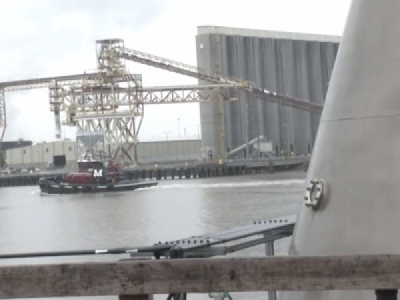
Posted on March 1, 2018
By JoAnn Merrigan, WSAV
Dredging of the Savannah Harbor is now halfway complete according to the U.S. Army Corps of Engineers. The Corps says about 20 miles of “outer” harbor (from Fort Pulaski to the ocean have now been dredged.)
The Savannah Harbor Expansion Project (SHEP) is seen as vital for the economy in terms of the Port of Savannah. Some large ships that are traveling through an expanded Panama Canal are making their way here, but cannot be loaded fully because the harbor is not deep enough to accommodate these big ships. That’s why up to 40 miles of the channel is being deepened from 42 to 47 feet.
When it comes to deepening the Savannah River which is part of the ‘inner” harbor project, there are environmental restrictions that the Corps says it is prepared to meet to allow a dredging contract to proceed.
That requirement is to replace depleted oxygen into the river to ensure the that fish survive.
“When you deepen the channel it brings salt water and chlorides further in upstream and what those do is they consume the oxygen that’s in the water,” says Russell Wicke, Army Corps of Engineers.
That’s why the Corps is installing what’s called a Dissolved Oxygen Injection System (in two places along the river) to put oxygen back into the river that the dredging will deplete.
“If they’re gong to deepen the harbor the only solution is to inject oxygen some way,” says Jacob Oblander who is the outreach coordinator for the Savannah Riverkeeper.
Oblander says even without dredging, oxygen levels are low in hot summer months and right now below state standards in the Savannah River.
The Corps says that’s why the project will put oxygen back. At Hutchinson Island, four large cones can be seen along with an elaborate pumping station. “This sucks in the river water and it generates oxygen on site from the ambient air and it mixes it together, oxygen is normally in a gas form and what it does is it dissolves that oxygen into the water so it stays in the water when we put it in.” says Wicke.
That water from the cone will be dispersed back into the river. It’s assumed this new and improved oxygenated water will be the answer to the depletion of oxygen from the dredging. ”
“Each of those cones produces a large amount of oxygen that gets diffused into the water, we’re talking 40 thousand pounds a day. In terms of oxygen, we’re highly confident that this is going to work,” said Wicke.
In addition to a system at Hutchinson Island that has four cones, there is a system further upstream at Plant McIntosh that has 8 cones.
The Corps says installation is 80 percent complete and the systems will be tested.
“One of our concerns though is when they’re doing the testing because the point is that these need to be most effective in August and September when our temperatures are very high and our dissolved oxygen level drops signifiicantly,” says Oblander. “We don’t want to have a large scale fish kill or anything like that to happen because there’s not enough oxygen in the water.”
“Hot weather is also when we have anadromous fish that live in both ocean and the river migrating through here,” said Oblander.”So if they’re migrating through a river with no oxygen they’re not going to make it to the main stem of the Savannah which sort of defeats their migration, that’s things like sturgeon and stripe bass for example”
Oblander also says he’s not aware of systems like this being used on such a large scale as the Savannah River. “I’m not confident that on this size scale it’s going to be as effective, I mean we’re not only talking about the harbor, the 22 miles here, we’re talking about the 170 miles impacting this whole system. I mean this is a major river – how much effect something like this is going go have we’ll have to wait to see.”
The Corps is confident this $100 million dollar system with work and says the results will be monitored. More importantly, this isn’t a suggestion, this is a requirement as a part of a lawsuit settlement with several environmental groups.
“We can’t award contract to deepen the inner harbor until the down river system is complete and we have tested, collected data and monitored the oxygen levels in the water and proven that our models did what we said they would do,” said Wicke.
Source: WSAV





